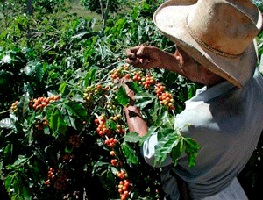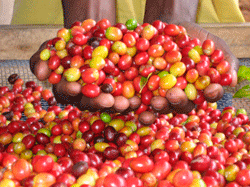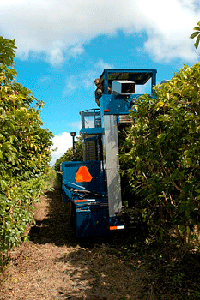

Each year coffee is harvested during the dry season when the coffee cherries are bright red, glossy, and firm. Ripe cherries are either harvested by hand, stripped from the tree with both unripe and overripe beans, or all the coffee beans are collected using a harvesting machine. These processes are called selective picking, stripping, and mechanical harvesting, respectively. To maximize the amount of ripe coffee harvested, it is necessary to selectively pick the ripe coffee beans from the tree by hand and leave behind unripe, green beans to be harvested at a later time. About 12-20 kg of export ready coffee will be produced from every 100 kg of coffee cherries harvested.

Depending on the grower, coffee pickers are sometimes specifically instructed to not pick green coffee berries since the seeds in the berries are not fully formed or mature. This discernment typically only occurs with growers who harvest for higher end/specialty coffee where the pickers are paid better for their labour. Mixes of green and red berries, or just green berries, are used to produce cheaper mass consumer coffee beans, which are characterized by a displeasingly bitter/astringent flavour and a sharp odour. Red berries, with their higher aromatic oil and lower organic acid content, are more fragrant, smooth, and mellow. As such coffee picking is one of the most important stages in coffee production, and is the chief determinant for the quality of the end product.

In Brazil, harvesting the same coffee tree several times is less cost effective than separating and discarding the unripe or overripe cherries. Therefore, Brazil typically harvests using the stripping method when 75% of the coffee crop is perfectly ripe. Stripping is feasible and cost effective in Brazil due to the uniform maturation of Brazilian coffees.
In stripping, the coffee beans are pulled from the tree and fall to the ground where they are caught by sheets. The beans are removed from tree debris by tossing the coffee in the air allowing the wind to carry away sticks and leaves. The coffee is then put in 60 L green baskets, which is the tool of measurement used by coffee producers to determine wages. Some coffee estates, such as Fazenda Monte Alegre in Sul de Minas Brazil, have a computerized system to determine wages for picking coffee beans. This system accounts for the amount of coffee collected from each person, the difficulty of the coffee harvesting conditions, and the production of the region being harvested.
Information Source: Coffee Research and Image Sources: Coffee Research, USAID and Kaanaapli Coffe Farms


















































